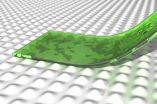(Press-News.org) Since the 1960s, theatergoers have shelled out for crude 3-D glasses, polarized glasses, and shutter glasses to enhance their viewing experience. These basic devices, used to trick the brain into perceiving an artificial three-dimensional reality, may soon be rendered obsolete with the introduction of new holography technology developed by Tel Aviv University researchers.
TAU doctoral students Yuval Yifat, Michal Eitan, and Zeev Iluz have developed highly efficient holography based on nanoantennas that could be used for security as well as medical and recreational purposes. Prof. Yael Hanein, of TAU's School of Electrical Engineering and head of TAU's Center for Nanoscience and Nanotechnology, and Prof. Jacob Scheuer and Prof. Amir Boag of the School of Electrical Engineering, led the development team. Their research, published in the American Chemical Society's publication Nano Letters, uses the parameters of light itself to create dynamic and complex holographic images.
In order to effect a three-dimensional projection using existing technology, two-dimensional images must be "replotted" — rotated and expanded to achieve three-dimension-like vision. But the team's nanoantenna technology permits newly designed holograms to replicate the appearance of depth without being replotted. The applications for the technology are vast and diverse, according to the researchers, who have already been approached by commercial entities interested in the technology.
Taking out the map
"We had this interesting idea — to play with the parameters of light, the phase of light," said Mr. Yifat. "If we could dynamically change the relation between light waves, we could create something that projected dynamically — like holographic television, for example. The applications for this are endless. If you take light and shine it on a specially engineered nanostructure, you can project it in any direction you want and in any form that you want. This leads to interesting results."
The researchers worked in the lab for over a year to develop and patent a small metallic nanoantenna chip that, together with an adapted holography algorithm, could determine the "phase map" of a light beam. "Phase corresponds with the distance light waves have to travel from the object you are looking at to your eye," said Prof. Hanein. "In real objects, our brains know how to interpret phase information so you get a feeling of depth, but when you look at a photograph, you often lose this information so the photographs look flat. Holograms save the phase information, which is the basis of 3-D imagery. This is truly one of the holy grails of visual technology."
According to the researchers, their methodology is the first of its kind to successfully produce high-resolution holographic imagery that can be projected efficiently in any direction.
"We can use this technology to reflect any desired object," said Prof. Scheuer. "Before, scientists were able to produce only basic shapes — circles and stripes, for example. We used, as our model, the logo of Tel Aviv University, which has a very specific design, and were able to achieve the best results seen yet."
The key to complex imagery
"This can be used for scientific research, security, medical, engineering, and recreational purposes," said Prof. Scheuer. "Imagine a surgeon, who is forced to replot several CAT-SCAN images to generate an accurate picture. By generating just one holographic image, she could examine symptoms from every angle. Similarly, an architect could draw up a holographic blueprint that he could actually walk through and inspect. The applications are truly endless."
The new technology could also be used to improve laser-based radars used for military purposes as well as advance anti-counterfeiting techniques that safeguard against theft.
"We optimized holograms to the highest resolution and created a new methodology able to produce any arbitrary image," said Prof. Scheuer. "Everything was done here, at the facilities of Tel Aviv University Center for Nanoscience and Nanotechnology; including the fabrication, characterization and experiments."
The researchers are currently developing technology that will allow holographic images to change shape and move.
INFORMATION:
American Friends of Tel Aviv University supports Israel's leading, most comprehensive and most sought-after center of higher learning, Tel Aviv University (TAU). Rooted in a pan-disciplinary approach to education, TAU is internationally recognized for the scope and groundbreaking nature of its research and scholarship — attracting world-class faculty and consistently producing cutting-edge work with profound implications for the future. TAU is independently ranked 116th among the world's top universities and #1 in Israel. It joins a handful of elite international universities that rank among the best producers of successful startups.
Projecting a 3-dimensional future
Tel Aviv University researchers develop holography technology that could change the way we view the world
2014-07-09
ELSE PRESS RELEASES FROM THIS DATE:
Shark teeth analysis provides detailed new look at Arctic climate change
2014-07-09
A new study shows that some shark species may be able to cope with the rising salinity of Arctic waters that may come with rising temperatures.
The Arctic today is best known for its tundra and polar bear population, but it wasn't always like that. Roughly 53 to 38 million years ago during what is known as the Eocene epoch, the Arctic was more similar to a huge temperate forest with brackish water, home to a variety of animal life, including ancestors of tapirs, hippo-like creatures, crocodiles and giant tortoises. Much of what is known about the region during this period ...
Making a more healthful, low-fat hot dog without giving up texture
2014-07-09
With grilling season upon us, many backyard cooks are turning to more healthful alternatives to their savored but fatty hot dogs. But low fat can sometimes mean low satisfaction. Now researchers are reporting new progress toward addressing the texture problem in low-fat wieners that are made with olive oil rather than pork fat. Their study was published in ACS' Journal of Agricultural and Food Chemistry.
Ana M. Herrero and colleagues note that hot-dog consumers have come to expect just the right amount of chewiness and springiness, among other things, from their beloved ...
Tiny DNA pyramids enter bacteria easily -- and deliver a deadly payload
2014-07-09
Bacterial infections usually announce themselves with pain and fever but often can be defeated with antibiotics — and then there are those that are sneaky and hard to beat. Now, scientists have built a new weapon against such pathogens in the form of tiny DNA pyramids. Published in the journal ACS Applied Materials & Interfaces, their study found the nanopyramids can flag bacteria and kill more of them than medicine alone.
David Leong, Jianping Xie and colleagues note that some infectious pathogens can lie in wait, undetectable in the human body or in places that antibiotics ...
My brother's keeper
2014-07-09
This news release is available in French.
Montreal, July 9, 2014 — Whether it's how to throw a ball or put together a puzzle, young children learn a lot from their older siblings. While researchers have long known that brothers and sisters teach each other about the world, most of their observations about this have been made in a lab setting.
A new study recently published in the Journal of Cognition and Development by Concordia University education professor Nina Howe takes that investigation a step further by observing how children interact in their natural habitat: ...
What drives a child to abuse alcohol?
2014-07-09
This news release is available in French. By looking at 40 different factors in 14 year old teens, including brain structure and function, personality, life experiences and genetics, researchers can predict with 70% accuracy who will go on to develop binge drinking within the next two years. Impulsivity, hopelessness, sensation-seeking traits, lack of conscientiousness, and other variables such as life events and a family history of drug use contribute to the likelihood of binge drinking. Whether or not the child had had a single drink at age 14 was a particularly ...
One secret of ancient amber revealed
2014-07-09
The warm beauty of amber was captivating and mysterious enough to inspire myths in ancient times, and even today, some of its secrets remain locked inside the fossilized tree resin. But for the first time, scientists have now solved at least one of its puzzles that had perplexed them for decades. Their report on a key aspect of the gemstone's architecture appears in the ACS journal Analytical Chemistry.
Jennifer Poulin and Kate Helwig of the Canadian Conservation Institute point out that much of the amber we see today had its origins millions of years ago, when it exuded ...
Sunshine vitamin ups bowel cancer survival odds, study finds
2014-07-09
Bowel cancer patients with high levels of vitamin D in their blood are more likely to survive the disease, a study shows.
Patients with the highest levels of vitamin D have half the risk of dying compared with those with the lowest levels, the findings reveal.
The study is the first to correlate total blood levels of vitamin D in bowel cancer patients after their diagnosis – which includes that produced after exposure to sunlight and that obtained from dietary sources – with their long term survival prospects.
The University of Edinburgh team tested blood samples ...
Short circuit in the food web
2014-07-09
Jena (Germany) They are amongst the most numerous inhabitants of the sea: tiny haptophytes of the type Emiliania huxleyi. Not visible to the naked eye, when they are in bloom in spring, they form square kilometer sized patches, they are even visible on satellite images. "Together with other phytoplankton, Emiliania huxleyi is responsible for approximately half of the global photosynthesis output," states Prof. Dr. Georg Pohnert of the Friedrich Schiller University Jena (Germany). In the process the greenhouse gas carbon dioxide – CO2 – is extracted from the atmosphere and ...
Fit for the frontline? New study identifies the hearing requirements of British soldiers
2014-07-09
AUDIO:
The gunshot is a binaural recording using KEMAR, the weapon was an SA80 assault rifle and the microphone is 50m downrange from the firer and approximately 30cm from the bullet...
Click here for more information.
University of Southampton researchers, with assistance from the Ministry of Defence, have conducted the first study to identify the hearing requirements of British soldiers fighting on the frontline.
The study, which provides an important and novel insight into ...
Even geckos can lose their grip
2014-07-09
Not even geckos and spiders can sit upside down forever. Nanophysics makes sure of that. Mechanics researchers at Linköping University have demonstrated this in an article just published in Physical Review E. Knowledge that can be of great industrial benefit.
Geckos and spiders that seem to be able to sit still forever, and walk around upside down have fascinated researchers worldwide for many years. We will soon be able to buy smart new fasteners that hold the same way as the gecko's foot. But the fact is, sooner or later the grip is lost, no matter how little force ...
LAST 30 PRESS RELEASES:
Drone sampling of whale breath reveals first evidence of potentially deadly virus in Arctic
Roman soldiers defending Hadrian’s Wall infected by parasites, study finds
Pinochet’s prisoners were tormented with music but still found solace in it, a new book reveals
Fertility remains high in rural Tanzania despite access to family planning
AI-assisted device can improve autism care access
Kinetic careers
Uncovering how parasitic plants avoid attacking themselves to improve crop resistance
Nanoparticle vaccine strategy could protect against Ebola and other deadly filoviruses
Study finds brain care score can predict risk of stroke across racial groups
Key lung immune cells can intensify allergic reactions
Do hormones explain why women experience more gut pain?
New materials conduct ions in solids as easily as in liquids
Breakthrough of the Year: Renewable energy begins to eclipse fossil fuel-based sources
LLM use is reshaping scientific enterprise by increasing output, reducing quality and more
Introducing LightGen, a chip for ultra-fast, ultra-efficient generative AI
Astronomers see fireworks from violent collisions around nearby star
ACC/AHA issue new guideline on managing congenital heart disease in adults
Cosmic crash caught on camera
Is talented youth nurtured the wrong way? New study shows: top performers develop differently than assumed
Ants: An untapped resource in the development of antibiotics?
Archaeologists use AI to create prehistoric video game
Mitochondria migrate toward the cell membrane in response to high glucose levels
Tiny viral switch offers hope against drug-resistant bacteria
Most parents aware of early peanut introduction guidelines, but confused about details
HPV vaccine can protect against severe lesions of the vulva and vagina
Virtual care provision and emergency department use among children and youth
Quadrivalent HPV vaccine and high-grade vulvovaginal lesions
Insights into dry eyes gained from stem cell-derived tear glands
Researchers identify 166 human pluripotent stem cell lines available for use in clinical applications
Europa Clipper instrument uniquely observed interstellar comet 3I/ATLAS
[Press-News.org] Projecting a 3-dimensional futureTel Aviv University researchers develop holography technology that could change the way we view the world


